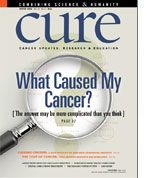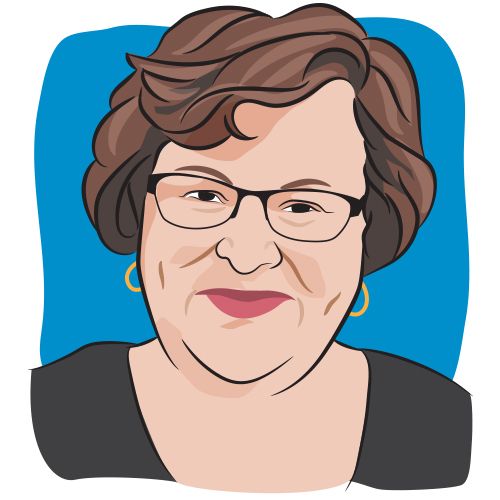Publication
Article
CURE
Brighter Horizons for Hodgkin Lymphoma Patients
Author(s):
The latest advancements in the treatment of Hodgkin lymphoma.
Three years ago, Stephen Dickter got sick. Pain behind his eyes, alarming swelling in his head and a terrible cough sent him to one doctor after another, who prescribed allergy medicines, steroids and inhalers. But nothing helped for long. In April 2009, Dickter landed in the emergency room with bulging veins in his chest and severely swollen eyes. There, a chest X-ray revealed a 17-centimeter tumor was pressing dangerously on his trachea and the blood vessels around his heart.
“All the doctors were looking from the neck up, and nobody thought to look from the neck down,” says Dickter, then 33, who received a diagnosis of stage 2B Hodgkin lymphoma (HL).
Two grueling rounds of chemotherapy and an autologous stem cell transplantation (a stem cell transplantation using the patient’s own cells) weren’t enough to conquer Dickter’s disease.
His symptoms returned in February 2011. He is now enrolled in a clinical trial for a recently approved drug called Adcetris (brentuximab vedotin), which is proving effective. His next step is an allogeneic stem cell transplantation, which, unlike his previous transplantation, calls for stem cells from a healthy donor—and Dickter’s brother is a match.
Roughly 8,800 people are diagnosed with HL each year. For most, the journey starts with the discovery of a lump or swollen lymph node, which is promptly biopsied and diagnosed. But the swollen nodes under Courtney Malcic’s left arm were first attributed to walking pneumonia; after chest pain and shortness of breath developed, it was thought to be pleurisy or valley fever. After the nodes had grown to the size of a golf ball and another was discovered near her collar bone, they were biopsied, and Malcic, 23, was told she had stage 2B HL.
HL strikes in two waves. It is most prevalent in young adults in their 20s or 30s, with a second spike in people aged 55 and older. And with few identifiable risk factors, apart from a slightly increased incidence in close relatives of HL patients, it strikes with little warning. There is some association between HL and infection with Epstein-Barr virus (EBV), the virus that causes infectious mononucleosis. But it’s unclear whether this is simply coincidence, because most people have been exposed to EBV and the virus infects the same cells that turn cancerous in HL.
Like Dickter and Malcic, about one-third of people experience symptoms, such as fever, weight loss and night sweats. These unfavorable “B” symptoms herald a more difficult-to-treat disease. A biopsy is required to reveal the telltale sign of classic HL: the presence of Reed-Sternberg cells. These are unusually large immune cells with multiple nuclei that arise from normally protective white blood cells called B cells. A more rare form of HL, called nodular lymphocyte-predominant HL, lacks Reed-Sternberg cells and instead harbors cancer cells with a popcorn-like appearance.
“One of the biggest challenges with this disease is adequate biopsy,” says Stephen Ansell, MD, PhD, an oncologist at the Mayo Clinic College of Medicine in Rochester, Minn. “A needle biopsy may miss the malignant cells because most of the cells around the Reed-Sternberg cells are actually normal, so a larger chunk can give you a better picture of the architecture of the cancer.”
Today, around 85 to 90 percent of people with HL are cured, even if the disease has spread widely throughout the person’s body.
Decades ago, radiation therapy over a large portion of the body was the only reliable way to treat early-stage HL. Today, a combination of chemotherapy with or without limited-field radiation is the norm and is effective in 90 to 95 percent of early-stage cases. And with both chemo and radiation, less is proving to be more.
Most patients with early-stage, uncomplicated HL receive two to four cycles of chemotherapy with a drug cocktail called ABVD (Adriamycin [doxorubicin], bleomycin, vinblastine and dacarbazine). Those with more extensive disease may receive the harsher dose-escalated BEACOPP (bleomycin, etoposide, Adriamycin, cyclophosphamide, Oncovin [vincristine], procarbazine and prednisone), which is initially more effective but carries a risk of more severe, long-term side effects.
Indeed, the benefits of a more aggressive initial chemotherapy might not outweigh the risks. In a recent study of patients with untreated, unfavorable HL, BEACOPP worked better than ABVD initially, but the two approaches came out even when results from those requiring secondary treatment were factored in. And more than half as many patients on ABVD suffered severe toxic effects compared with those on BEACOPP. Another study suggested that both the number of cycles of ABVD and the dose of radiation could be decreased without negatively affecting efficacy.
The good news is that 90 to 95 percent of patients with HL respond to initial treatment. But even in those who respond initially, cancer returns in 10 to 30 percent of cases.
Expecting complete remission, Drake was shocked when a post-treatment scan revealed that the cancer had not been eliminated. A second round of chemotherapy works in some cases of relapsed disease, but early clinical trials suggest that high-dose chemotherapy followed by an autologous stem cell transplantation may be a better option than chemotherapy alone and provide superior long-term survival in 30 to 65 percent of patients.
Drake didn’t respond to the drugs used to coax the stem cells out of her bone marrow for an autologous transplantation, so instead she received an allogeneic transplantation from a healthy donor. The first scan after the transplantation showed no signs of cancer, but her subsequent scans were ambiguous, leaving Drake feeling cautiously optimistic. “Right now, I’m trying to not dwell on it constantly,” she says. “It just feels so good to feel good.”
Autologous stem cell transplantation is effective in about half of patients with recurrent or progressive HL, but Dickter’s transplantation kept his cancer at bay for only a few months. Patients whose cancer returns at this stage have few options and a poor prognosis, with an average survival time of 26 months.
But the outlook may not be as grim as it once was. The FDA recently granted accelerated approval for the use of Adcetris in patients with relapsed or refractory HL and anaplastic large-cell lymphoma. It is the first new drug approved for the treatment of HL since 1977.
In a phase 1 trial of patients with relapsed or refractory HL conducted at M.D. Anderson Cancer Center in Houston, tumors regressed in 86 percent of patients taking Adcetris, with a complete remission in 11 individuals (24 percent). Dickter was enrolled in a phase 2 clinical trial at the City of Hope in California. “The first week I was on [Adcetris], I could actually feel it working in my chest,” he says. “I could feel the tumor melting away.”
Adcetris is a type of drug known as an antibody-drug conjugate or immunoconjugate. “It’s a magic bullet-type approach,” Connors says. One part of the compound (the antibody) targets a protein called CD30, which is abundant on HL cells but is not expressed by most healthy white blood cells. The other half is a drug called MMAE, which poisons the cell. Another example of an antibody-drug conjugate is T-DM1 (trastuzumab emtansine), which combines the effective breast cancer drug Herceptin (trastuzumab) with another toxin and has shown promise in patients with metastatic HER2-positive breast cancer. “[This class of drug is] so effectively delivered to the cancerous cells, you only need to put a very small amount of the toxic material into the patient,” Connors explains.
“With accelerated approval, you don’t get carte blanche,” Ansell says. Further studies are required to confirm Adcetris’ clinical benefit in HL patients.
The side effects of Adcetris are relatively mild and include fatigue, neutropenia, fever, nausea and peripheral neuropathy (nerve damage, which can feel like tingling or numbness in the hands and feet). “Compared to what I’ve been through before, the side effects are pretty mild,” says Dickter, whose cancer receded significantly after only two doses of the drug. A complete response will give Dickter a green-light for allogeneic transplantation.
Another class of anti-tumor drug, called histone deacetylase (HDAC) inhibitors, has shown promise in early clinical trials for relapsed and refractory lymphoma. HDAC inhibitors, including panobinostat and entinostat, work by changing the structure of the DNA complex inside the cell. “Some cancers allow genes to be expressed that shouldn’t be expressed,” Connors says. “By changing the incorrect way that the DNA is being regulated, it’s hoped that the drugs will alter gene expression back toward normal.” Drugs that target growth factor receptor pathways, such as mTOR and PI3K inhibitors, are being explored in many common adult cancers and are also being tested in relapsed HL.
The recent approval of Adcetris means an even brighter outlook for patients with HL. In the meantime, Dickter, Drake and Malcic await their next scans. While Dickter is banking on his allogeneic transplantation, Malcic is hoping she won’t need one. And Drake is simply hoping to hear the word “remission.”
Rosie Drake was 57 when she received her diagnosis of stage 2A HL, and she “was relieved that it was Hodgkin lymphoma,” she says, “because I knew that HL was so curable and so treatable.” Indeed, HL is often referred to as the “good” cancer because of its relatively high cure rate. “Today, around 85 to 90 percent of people with HL are cured, even if the disease has spread widely throughout the person’s body,” says Joseph Connors, MD, clinical director of the Centre for Lymphoid Cancer at the British Columbia Cancer Agency in Vancouver.
The odds are best for patients like Drake with early-stage disease (stage 1-2), in which the cancer is confined to one or two lymph node groups on the same side of the diaphragm. Patients with cancer in lymph nodes on both sides of the diaphragm and those whose disease has spread into other organs and tissues are at a more advanced stage of the disease (stage 3-4). The presence of B symptoms means a less favorable prognosis regardless of the stage (their absence is denoted by an “A”). “Risk factors [for HL] are not hard to understand,” Connors says. “The more cancer a person has, the harder it’s going to be to get rid of.”
View Illustration: Hodgkin Lymphoma Staging
There’s a big argument over who gets radiation, says James Armitage, MD, an oncologist at the University of Nebraska Medical Center in Omaha. “Because radiation has a lot of long-term shortcomings, there’s been a real effort to try to minimize its use,” which is most frequent in patients with larger tumors.
The less-is-more approach helps avert the side effects of both chemotherapy and radiation. Besides the typical acute symptoms of nausea and hair loss, chemotherapy drugs can also trigger secondary leukemias, heart and lung damage. In the first five to 10 years after receiving an HL diagnosis, patients’ biggest risk is HL itself, Armitage explains. “As time passes, a variety of other side effects—mostly due to radiation—become more important.” Later effects include radiation-induced secondary cancers, particularly breast cancer in women who are treated at a young age, along with heart disease and infertility.
After two or three rounds of chemotherapy, most patients get a PET scan, in which they are injected with a radioactive sugar. Because active cancer cells generally use more sugar than normal cells, visible “hot spots” show up on the image. A negative PET result partway through treatment is an excellent sign. But whether an interim PET scan should be used to modify further treatment is a matter of debate. “The challenge is demonstrating that [a change of treatment] actually makes things turn out better,” says Connors, and this awaits clinical trials.
View Chart: Hodgkin Lymphoma Treatment Options





